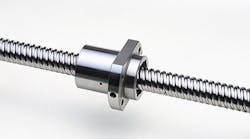For centuries, the conventional lead screw (threaded shaft and nut) was the primary mechanism for converting rotary motion to linear motion. They were inexpensive to manufacture and reliable.
Ball screws date all the way back to the late 19th century, when some ingenious engineer placed ball bearings inside the nut threads to reduce friction. This eventually led to efficiencies of over 90% and the elimination of backlash.
In 1898, The Practical Machinist published what may have been the first publicly-documented ball screw. The Cleveland Machine Screw Co. is credited with the design. However, the performance of this device was probably quite limited. Ball bearings were just emerging around that time, so the most likely limitation was inconsistently sized balls, making recurring jams in the return tubes a problem. It was not until the post-war era that ball-bearing fabrication caught up, which partially took care of the problem. But return tubes were still a problem.
One of the first commercial ball screws was designed into the famous Saginaw steering gear. This gear was used on many vehicles as diverse as the Ford Fairlane (1956-78) and Chevrolet Corvette (1962-82). The Saginaw design used a ball screw to transform rotation of the steering wheel into perpendicular linear motion of a rack. It featured a tube return. Actually, two tubes were employed to recirculate the several dozen balls on separate circuits. No pre-loading was necessary due to the coarse positioning requirements. However, the tubes were still subject to jamming. To mitigate this problem, some designs used alternating balls, with every other one 0.001 in. larger than its neighbors.
Bruce Gretz is National Key Accounts Manager for Steinmeyer Inc.
